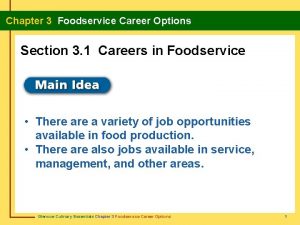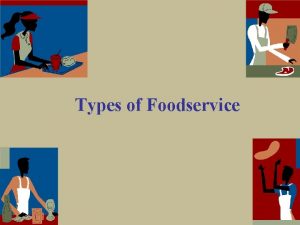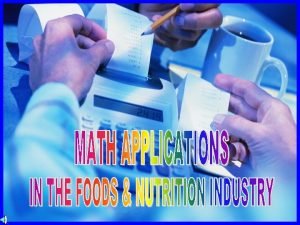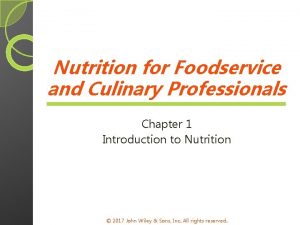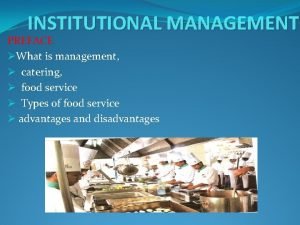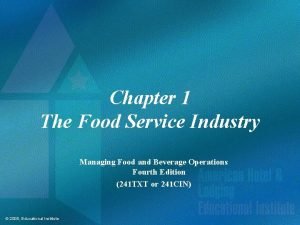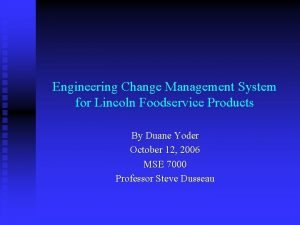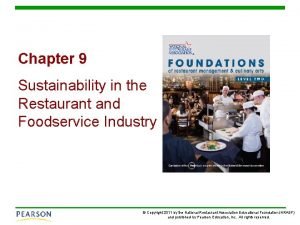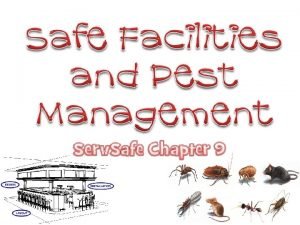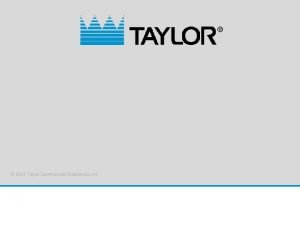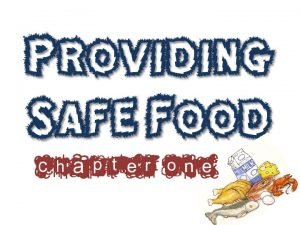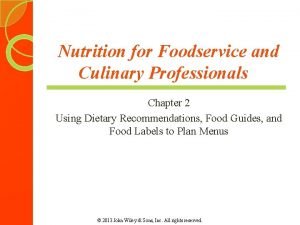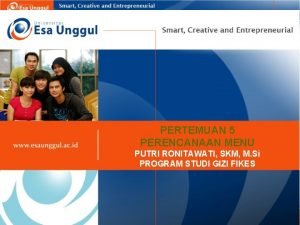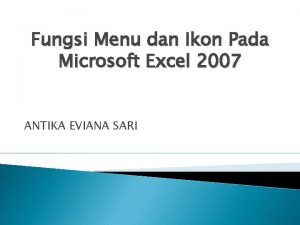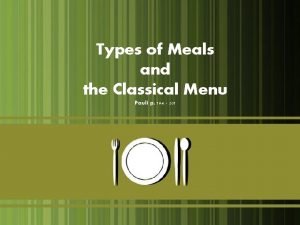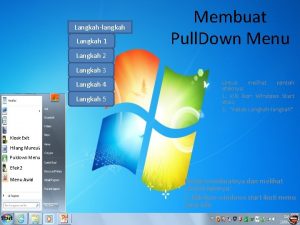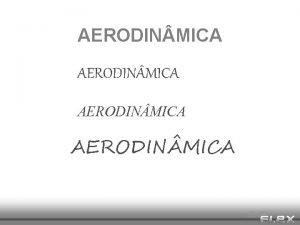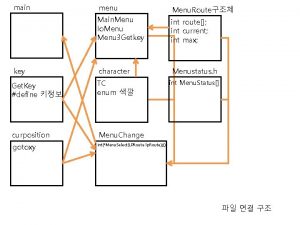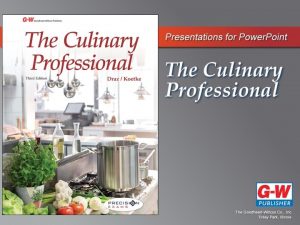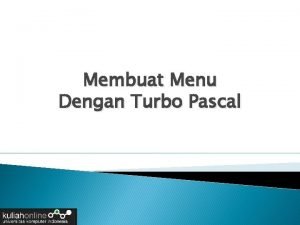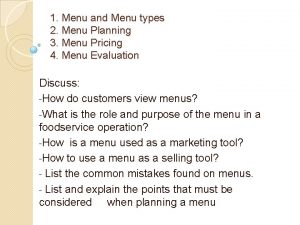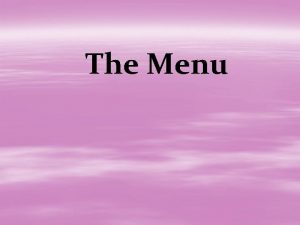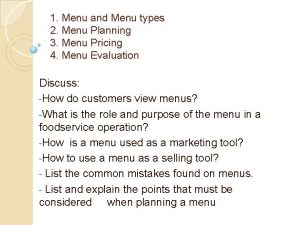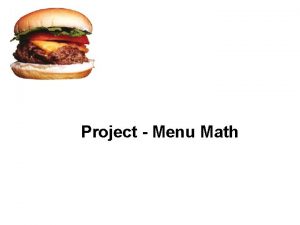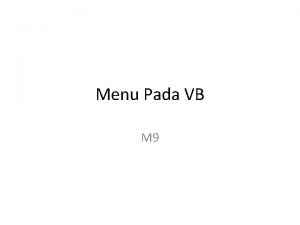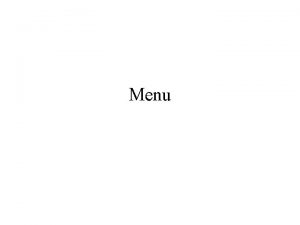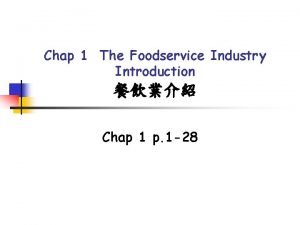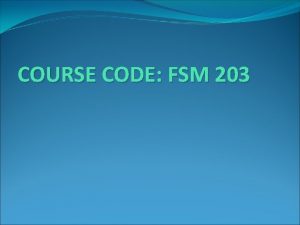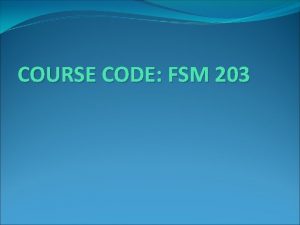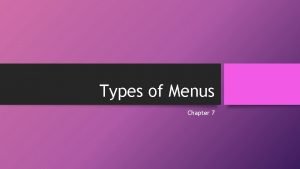Chapter 5 The Menu Introduction to Foodservice tenth





























- Slides: 29

Chapter 5 The Menu Introduction to Foodservice, tenth edition Payne-Palacio/Theis © 2005 Pearson Education, Inc. Upper Saddle River, New Jersey 07458

Outline § Menu planning • • • Organizational mission and goals The customer Budget guidelines Production and service capabilities Availability of food Style of service Introduction to Foodservice, tenth edition Payne-Palacio/Theis © 2005 Pearson Education, Inc. Upper Saddle River, New Jersey 07458

Outline continued § Menu planning continued • Types of menus • Menu patterns • Food characteristics and combinations § Menu writing • Timetable for planning, development, and implementation • Steps in menu development Introduction to Foodservice, tenth edition Payne-Palacio/Theis © 2005 Pearson Education, Inc. Upper Saddle River, New Jersey 07458

Outline continued § Customer satisfaction • Surveys and comment cards • Frequency ratings or popularity indexes • Sales data § Summary Introduction to Foodservice, tenth edition Payne-Palacio/Theis © 2005 Pearson Education, Inc. Upper Saddle River, New Jersey 07458

Outline continued § Menu writing continued • Menu evaluation • Writing menus for modified diets § The printed menu • Menu design and format • Menu marketing Introduction to Foodservice, tenth edition Payne-Palacio/Theis © 2005 Pearson Education, Inc. Upper Saddle River, New Jersey 07458

Introduction § The menu is the single most important tool in a foodservice operation. § A well-planned menu serves as a catalyst that drives all operational functions: purchasing, production, assembly, distribution, service, and sanitation. Introduction to Foodservice, tenth edition Payne-Palacio/Theis © 2005 Pearson Education, Inc. Upper Saddle River, New Jersey 07458

Menu Planning § In planning a menu, there are many factors to consider. These factors tend to fall into three categories of influence including: • Organizational • Customer • Operational and managerial Introduction to Foodservice, tenth edition Payne-Palacio/Theis © 2005 Pearson Education, Inc. Upper Saddle River, New Jersey 07458

Menu Planning § Organizational mission and goals • The menu must reflect the organization’s stated purpose as defined in the mission statement. § The customer • The demographics, sociocultural influences, and eating habits of a population must be taken into consideration when planning a menu. Introduction to Foodservice, tenth edition Payne-Palacio/Theis © 2005 Pearson Education, Inc. Upper Saddle River, New Jersey 07458

Menu Planning § Demographics • Trends in the statistics of populations, such as age, gender, and ethnicity are important to the menu planner because they vary among population groups and change frequently. § Sociocultural influences • Factors such as marital status, lifestyle, ethnic background, values, and religion of the customer greatly impact menu planning. Introduction to Foodservice, tenth edition Payne-Palacio/Theis © 2005 Pearson Education, Inc. Upper Saddle River, New Jersey 07458

Menu Planning § Nutritional Requirements • Nutritional requirements vary depending on the type of foodservice and population served. § For example, in the Child Nutrition Program, the meals must comply with nutrient standards to quality for federal reimbursement. § RDA (Recommended Daily Allowance): levels of essential nutrients considered to be adequate to meet known need of practically all healthy persons; some foodservices use as a nutrient guide. Introduction to Foodservice, tenth edition Payne-Palacio/Theis © 2005 Pearson Education, Inc. Upper Saddle River, New Jersey 07458

Menu Planning § Dietary Reference Intakes (DRI) • Nutrient recommendations that address the needs of specific groups and individuals § Food consumption, trends, habits, and preferences • Food habits are mostly based on ethnic and cultural background, but in today’s society, people are becoming more knowledgeable about ethnic and regional foods. Introduction to Foodservice, tenth edition Payne-Palacio/Theis © 2005 Pearson Education, Inc. Upper Saddle River, New Jersey 07458

Menu Planning § Budget guidelines • In retail operations, the amount to be budgeted is based on projected income from the sale of food. • This income must generate adequate revenue to cover raw food cost, labor, operating expenses, and allow for desired profit. Introduction to Foodservice, tenth edition Payne-Palacio/Theis © 2005 Pearson Education, Inc. Upper Saddle River, New Jersey 07458

Menu Planning: Production and Service Capabilities § Equipment and physical facilities • The menu planned for any given day must be one that can be produced in the available work space and with the available equipment. § Personnel • Understanding the relationship between the menu and the availability and the skill of employees are factors to consider in determining the complexity of the menu. Introduction to Foodservice, tenth edition Payne-Palacio/Theis © 2005 Pearson Education, Inc. Upper Saddle River, New Jersey 07458

Menu Planning: Production and Service Capabilities § Availability of food • The location of the foodservice operation to the source of food and the dynamics of the market can affect what foods are available on the menu. § Style of service • Some foods are more adaptable to seated service, some to cafeteria style. • The distance between the point of preparation and point of service needs to be considered. Introduction to Foodservice, tenth edition Payne-Palacio/Theis © 2005 Pearson Education, Inc. Upper Saddle River, New Jersey 07458

Menu Planning: Production and Service Capabilities § Extent of selection • Selective menu: a menu that includes two or more food choices in each menu category such as appetizers, entrees, vegetables, salads, and desserts. • Semiselective menu: a menu that includes one or more food choices in at least one menu category. • Nonselective menu: a menu that offers no choice of food items. Introduction to Foodservice, tenth edition Payne-Palacio/Theis © 2005 Pearson Education, Inc. Upper Saddle River, New Jersey 07458

Menu Planning: Production and Service Capabilities § Extent of selection continued • Static menu: a menu that is used each day, such as a restaurant menu. • Single-use menu: a menu specifically planned and used only once, usually for a holiday or catered event. • Cycle menu: a carefully planned set of menus that is rotated at definite time intervals. Introduction to Foodservice, tenth edition Payne-Palacio/Theis © 2005 Pearson Education, Inc. Upper Saddle River, New Jersey 07458

Menu Planning: Production and Service Capabilities § Extent of selection continued • Table d’hôte menu: a menu that offers a complete meal at a fixed price. • Du jour menu: menu of the day. Introduction to Foodservice, tenth edition Payne-Palacio/Theis © 2005 Pearson Education, Inc. Upper Saddle River, New Jersey 07458

Menu Planning: Production and Service Capabilities § Menu patterns • An outline of food to be included in each meal, and the extent of choice at each meal. § Food characteristics and combinations • One must consider presentation, color, texture, consistency, shape, flavor combinations, and variety in preparation when planning a menu. Introduction to Foodservice, tenth edition Payne-Palacio/Theis © 2005 Pearson Education, Inc. Upper Saddle River, New Jersey 07458

Menu Writing § Timetable for planning, development, and implementation • How far in advance of production and service menus should be planned depends on the type of menu, extent of selections, and size and complexity of the foodservice operation. Introduction to Foodservice, tenth edition Payne-Palacio/Theis © 2005 Pearson Education, Inc. Upper Saddle River, New Jersey 07458

Menu Writing: Steps in Menu Development • • Entrees Soups and sandwiches Vegetables and “sides” Salads Introduction to Foodservice, tenth edition Payne-Palacio/Theis • • • Desserts Garnishes Breads Breakfast items Beverages © 2005 Pearson Education, Inc. Upper Saddle River, New Jersey 07458

Menu Writing § Checklist for menu evaluation • The menu should be evaluated prior to use, and on an ongoing basis. • Figure 5. 10 is an example of a menu evaluation tool. Introduction to Foodservice, tenth edition Payne-Palacio/Theis © 2005 Pearson Education, Inc. Upper Saddle River, New Jersey 07458

Menu Evaluation Form Introduction to Foodservice, tenth edition Payne-Palacio/Theis © 2005 Pearson Education, Inc. Upper Saddle River, New Jersey 07458

Menu Writing § Writing menus for modified diets • In many foodservice departments, especially those affiliated with health care, the foodservice department is responsible for ensuring that physician-ordered diets are provided accurately. § Menus as documents • Printed master menus for both general and modified diets are excellent documents for department evaluation and budget planning. Introduction to Foodservice, tenth edition Payne-Palacio/Theis © 2005 Pearson Education, Inc. Upper Saddle River, New Jersey 07458

The Printed Menu § Menu design and format • A menu should appeal to the guest, stimulate sales, influence the client, and be clean and simple in design and format. § Descriptive wording • Menus should present an accurate word picture of the foods available. Introduction to Foodservice, tenth edition Payne-Palacio/Theis © 2005 Pearson Education, Inc. Upper Saddle River, New Jersey 07458

The Printed Menu § Truth-in-menu legislation • Truth-in-menu laws require that the menu accurately describes the foods to be served. Giving misleading names to menu items is illegal. § Menu marketing • The manner in which food choices are presented to potential customers can have a significant impact on sales. Introduction to Foodservice, tenth edition Payne-Palacio/Theis © 2005 Pearson Education, Inc. Upper Saddle River, New Jersey 07458

The Printed Menu § Spoken menus • A means of communicating menu choices by reading the menu to the customer in lieu of a printed menu. • In hospitals, as a result of shorter stays and the cost of printing menus, spoken menus have become an alternative. Introduction to Foodservice, tenth edition Payne-Palacio/Theis © 2005 Pearson Education, Inc. Upper Saddle River, New Jersey 07458

Customer Satisfaction § Surveys and comment cards • Satisfaction surveys can be done formally via written surveys and comment cards, sometimes conducted by outside agencies. • Statistics and trends reported by these outside agencies can be used in benchmarking, where satisfaction levels determined for one facility can be compared with those of other similar facilities. Introduction to Foodservice, tenth edition Payne-Palacio/Theis © 2005 Pearson Education, Inc. Upper Saddle River, New Jersey 07458

Customer Satisfaction § Frequency ratings or popularity indexes • These are established via formal or informal surveys in which customers are asked to rate or rank menu items according to preference. § Sales data • Sales data that is tracked by modern registers can be used to revise an existing menu or plan a new one. Introduction to Foodservice, tenth edition Payne-Palacio/Theis © 2005 Pearson Education, Inc. Upper Saddle River, New Jersey 07458

Summary § In planning a menu, many factors must be considered. § The menu can take different forms, each written for the needs of a particular type of foodservice. § Systematic planning procedures that include continuous evaluation of the menus as served should be followed. Introduction to Foodservice, tenth edition Payne-Palacio/Theis © 2005 Pearson Education, Inc. Upper Saddle River, New Jersey 07458
 Introduction to genetic analysis tenth edition
Introduction to genetic analysis tenth edition Chapter 3 food service career options worksheet answers
Chapter 3 food service career options worksheet answers Understanding foodservice operations chapter 2
Understanding foodservice operations chapter 2 Tenth chapter wired
Tenth chapter wired Types of food services
Types of food services Math is not an essential skill for foodservice managers.
Math is not an essential skill for foodservice managers. Nutrition for foodservice and culinary professionals
Nutrition for foodservice and culinary professionals Institutional catering examples
Institutional catering examples Commercial and non commercial food service
Commercial and non commercial food service Tipe penyelenggaraan makanan
Tipe penyelenggaraan makanan Lincoln foodservice products
Lincoln foodservice products Sustainability in the restaurant and foodservice industry
Sustainability in the restaurant and foodservice industry Noncommercial food service examples
Noncommercial food service examples The only completely reliable backflow prevention
The only completely reliable backflow prevention Taylor commercial foodservice
Taylor commercial foodservice Inspects retail and foodservice operations
Inspects retail and foodservice operations Nutrition for foodservice and culinary professionals
Nutrition for foodservice and culinary professionals Nutrition for foodservice and culinary professionals
Nutrition for foodservice and culinary professionals Nnn foodservice solutions
Nnn foodservice solutions Langkah perencanaan menu
Langkah perencanaan menu Ikon microsoft excel
Ikon microsoft excel Difference between classical menu and modern menu
Difference between classical menu and modern menu Bagian bagian browser
Bagian bagian browser Menu pull down
Menu pull down The tenth man graham greene summary
The tenth man graham greene summary Where is the ten thousands place
Where is the ten thousands place Campbell biology tenth edition
Campbell biology tenth edition Campbell biology tenth edition
Campbell biology tenth edition Campbell biology tenth edition
Campbell biology tenth edition Round off of 75
Round off of 75

